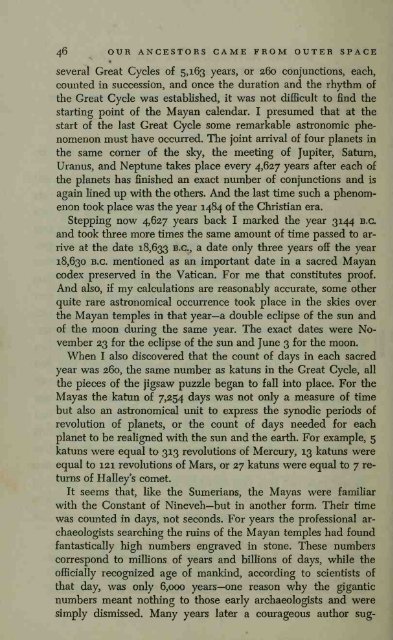Create successful ePaper yourself
Turn your PDF publications into a flip-book with our unique Google optimized e-Paper software.
46 OUR ANCESTORS CAME FROM OUTER SPACE<br />
several Great Cycles of 5,163 years, or 260 conjunctions, each,<br />
counted in succession, and once the duration and the rhythm of<br />
the Great Cycle was established, it was not diflBcult to find the<br />
starting point of the Mayan calendar. I presumed that at the<br />
start of the last Great Cycle some remarkable astronomic phenomenon<br />
must have occurred. The joint arrival of four planets in<br />
the same corner of the sky, the meeting of Jupiter, Saturn,<br />
Uranus, and Neptune takes place every 4,627 years after each of<br />
the planets has finished an exact number of conjunctions and is<br />
again lined up with the others. And the last time such a phenomenon<br />
took place was the year 1484 of the Christian era.<br />
Stepping now 4,627 years back I marked the year 3144 B.C.<br />
and took three more times the same amount of time passed to arrive<br />
at the date 18,633 B.C., a date only three years oflF the year<br />
18,630 B.C. mentioned as an important date in a sacred Mayan<br />
codex preserved in the Vatican. For me that constitutes proof.<br />
And also, if my calculations are reasonably accurate, some other<br />
quite rare astronomical occurrence took place in the skies over<br />
the Mayan temples in that year—a double eclipse of the sun and<br />
of the moon during the same year. The exact dates were November<br />
23 for the eclipse of the sun and June 3 for the moon.<br />
When I also discovered that the count of days in each sacred<br />
year was 260, the same number as katuns in the Great Cycle, all<br />
the pieces of the jigsaw puzzle began to fall into place. For the<br />
Mayas the katun of 7,254 days was not only a measure of time<br />
but also an astronomical unit to express the synodic periods of<br />
revolution of planets, or the count of days needed for each<br />
planet to be realigned with the sun and the earth. For example, 5<br />
katuns were equal to 313 revolutions of Mercury, 13 katuns were<br />
equal to 121 revolutions of Mars, or 27 katuns were equal to 7 returns<br />
of Halley's comet.<br />
It seems that, like the Sumerians, the Mayas were familiar<br />
with the Constant of Nineveh—but in another form. Their time<br />
was counted in days, not seconds. For years the professional archaeologists<br />
searching the ruins of the Mayan temples had found<br />
fantastically high numbers engraved in stone. These numbers<br />
correspond to millions of years and billions of days, while the<br />
oflBcially recognized age of mankind, according to scientists of<br />
that day, was only 6,000 years—one reason why the gigantic<br />
numbers meant nothing to those early archaeologists and were<br />
simply dismissed. Many years later a courageous author sug-

















